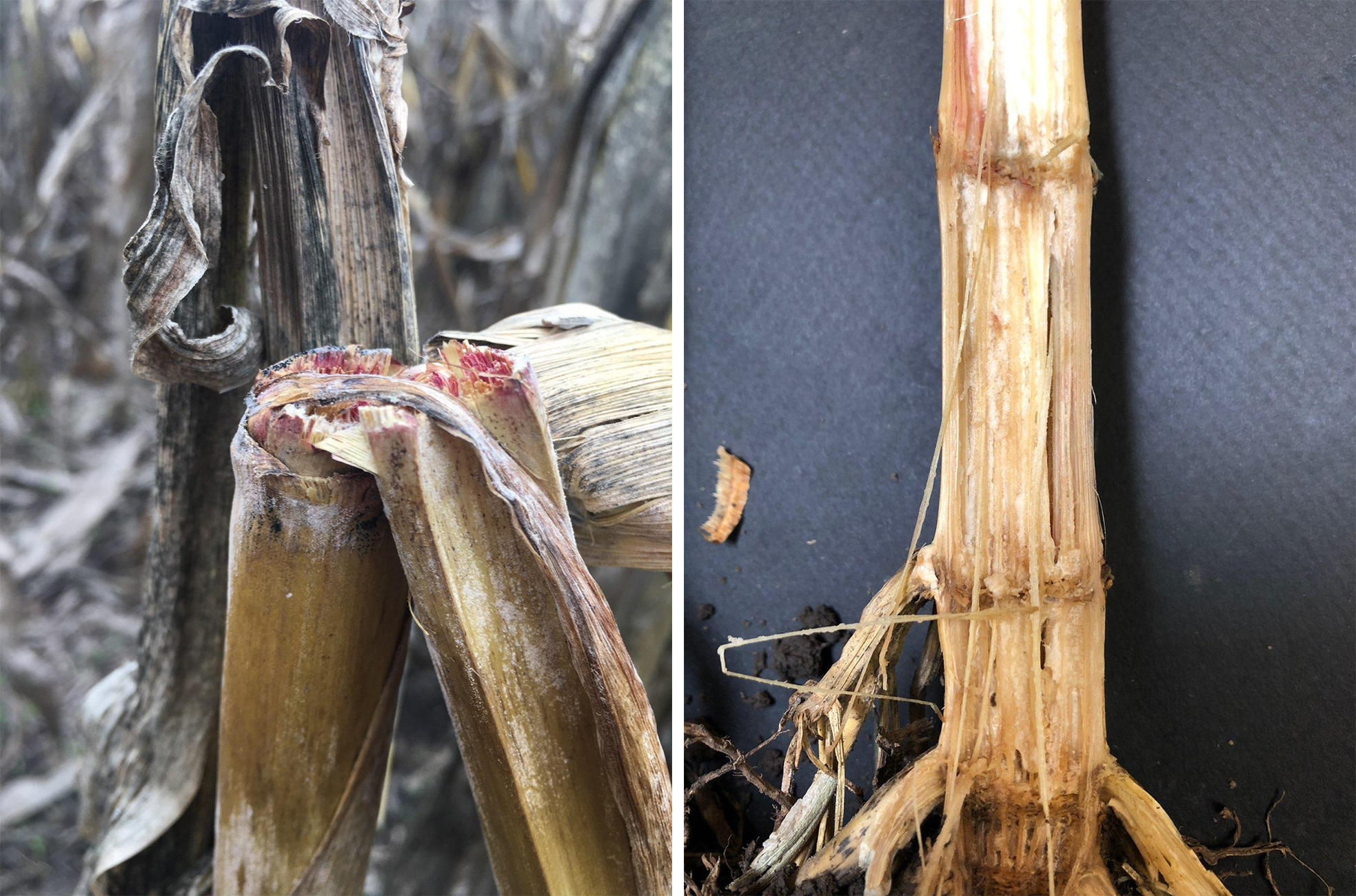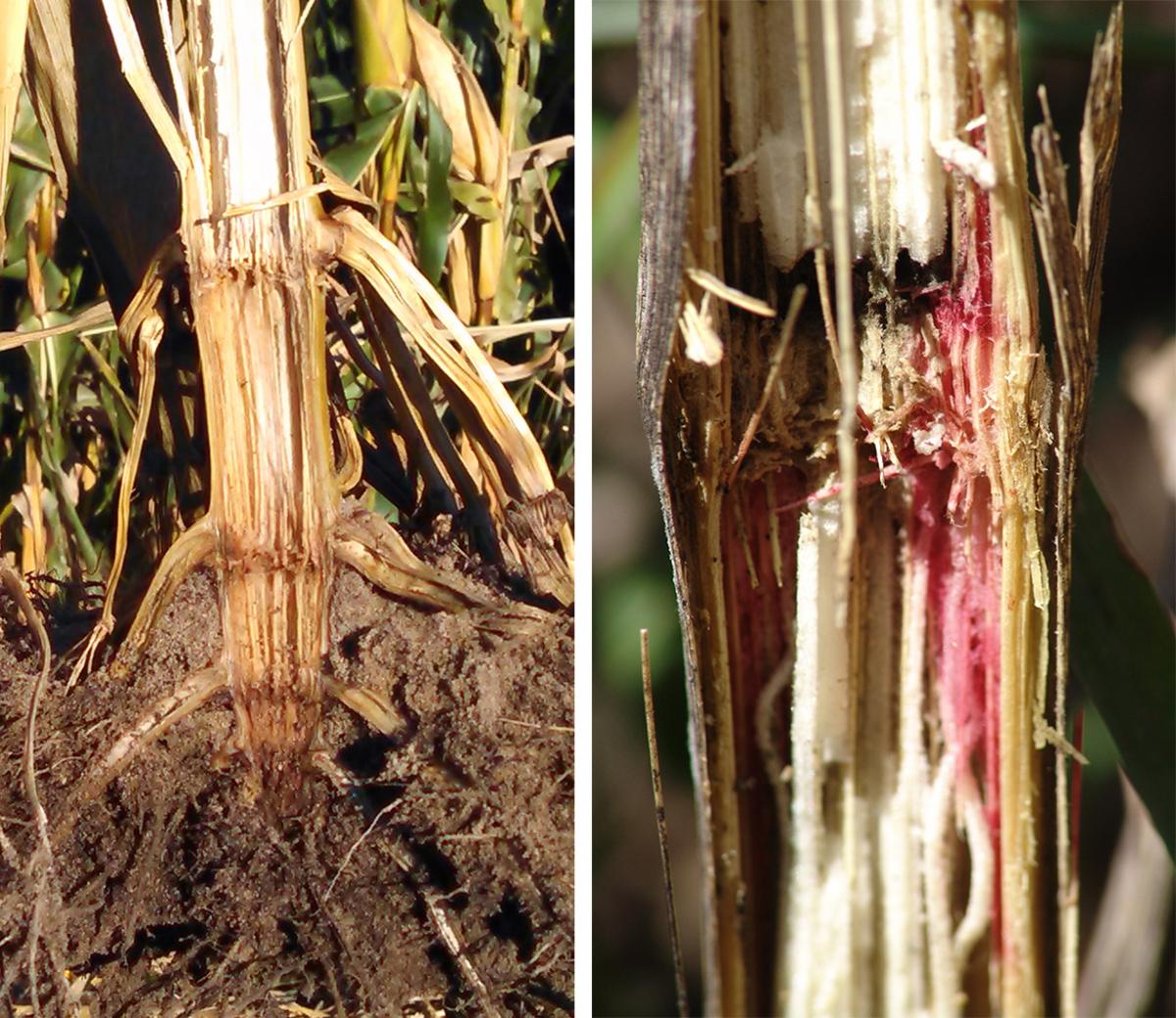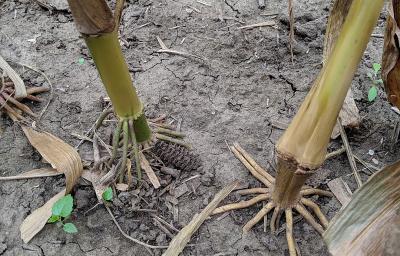Diplodia stalk rot is caused by the fungus Diplopia Maydis which also causes ear rot. Early-season seedling diseases can cause stalk rot issues in some area corn fields.

Stalk Rot Impacts Yield Requires Special Attention Crops Agupdate Com
It is very important to consider these factors when attempting to diagnose problems in the field.

What causes stalk rot in corn. This infection can develop into crown rot. It is also the only corn stalk rot disease with a. It causes decay of the first internode above the soil.
Fields that experienced wet growing conditions in the spring may have been infected by Fusarium species. Premature plant death interrupts grain-fill and causes yield losses. Bacterial stalk rot is caused by Erwinia dissolvens.
The sclerotia germinates on the root surface and penetrates the host epidermal cells of the corn. The fungus overwinters on the residue of corn and wheat. Although pathogenic infectious organisms cause the majority of stalk rots a variety of abiotic noninfectious factors and insect feeding damage can also cause corn stalks to become weak and lodge.
The rind and the pith become soft brown and water-soaked. It is one of the most important diseases in the Corn Belt. Anthracnose is the most common stalk rot disease faced by corn growers worldwide with yield losses reaching as high as 40 as a result of reduced ear size and stalk lodging.
Fields that experienced wet growing conditions in the spring may have been infected by Fusarium species. Rot and Colletotrichum graminicola the cause of anthracnose stalk rot. Several fungal pathogens cause stalk rots but this season the stalk rots being observed in corn fields are those.
Corn stalk rots are mainly caused by fungal pathogens though bacterial infections and insect injury can also lead to stalk rot development. Therefore the identification of a specific organism causing the stalk rot is often difficult. Ear rot usually starts at the base of ears and eventually the whole ear may rot.
In addition to stalk. Affected plants have shredded pith that may be a. Corn is infected during dry periods where the temperature hits 80-85 ºF 27-29 ºC.
Early-season seedling diseases can cause stalk rot issues in some area corn fields. As with many diseases in corn timing of stress to corn plants can also cause stalk rot incidence as are temperature moisture stress seed genetics and fertility. Charcoal rot begins as a root infection which spreads into the lower stalk internodes and causes early ripening shredding and breaking at the crown of the corn stalk.
Occasionally Diplodia maydis the cause of Diplodia stalk rot can be found on corn but it is much more important as an ear rotting organism. Infections can occur within two weeks after silking. Anthracnose has both a leaf and a stalk phase in corn.
Anthracnose Stalk Rot Colletotrichum graminicola causes several anthracnose diseases of corn including stalk rot top dieback and foliar and seedling diseases. Gibberella ear rot produces mycotoxins in corn including deoxynivalenol DON also call vomitoxin. Verticillioides the primary causal pathogen.
This fungus is an aggressive pathogen of corn and is one of the few stalk rot pathogens that frequently causes disease prior to senescence. The common stalk rot. Lodging can be much worse when stalks are already.
Gibberella Ear Rot and Stalk Rot in Corn. Identifying stalk rot and ear rot Rather than identifying which stalk or ear rot fungi is present locating a presence of rot can be more important for making harvest management decisions. Root and crown rots developing in corn after the seedling stage are usually caused by Fusarium spp.
The majority of stalk rot damage in Ontario is caused by three fungi Anthracnose Gibberella and Fusarium. Crown Rot in Corn. Affected plants have a foul odor.
Fusarium stalk rot of corn. Infection is favored by warm temperatures 70-80 F and high humidity. Bacterial stalk rot is not common but often shows up with overhead irrigation of corn especially where the water source is a lake pond or slow-moving stream.
The development of bacterial soft rot like Pythium stalk rot is favored by high temperatures 85 to 95 F 29 to 35 C and poor air circulation. Several fungi and bacteria can cause stalk rots. This infection can develop into crown rot which is observed as mid-late season stalk lodging.
General infection may occur following flooding or where corn is sprinkler-irrigated from a surface source of water such as a river farm pond or lake. Gibberella stalk rot and ear rot are caused by the fungus Gibberella zeae the same pathogen that causes head scab of wheat Fusarium graminearum. The stalk typically twists and falls over but the plant may remain green for several weeks because the vascular tissue is not destroyed.
However Diplodia and Pythium have also been observed. Although these fungi cause different symptoms their ultimate effect on the corn plant is the same. In more advanced stages the disease can cause the development of black lesions visible on the outside of.
Bacterial stalk rot of corn. On grain sorghum stalk rot is caused by F. Corn stalk rots and lodging are usually the result of an interaction between weather fertility compaction leaf disease plant population planting date and kernel fill.
And can be enhanced by injury to the roots or crown mainly by insect feeding. Anthracnose stalk rot is caused by the fungus Colletotrichum graminicola which also causes a leaf disease and is a common cause of top rot disease of corn. Stalk rots result from the combined effects of more than one organism that attacks plants approaching maturity.
It is among the most common stalk rots in the Midwest with F. Bacterial stalk rot of corn is favored under conditions of high air temperatures and wet weather or high humidity. Infected plants were wilting and upon splitting of the lower nodes revealed brown discoloration of the pith.
Fusarium stalk rot is caused by multiple fungal pathogens in the Fusarium genus.

Pdf Common Stalk Rot Diseases Of Corn

Symptoms Of Post Flowering Stalk Rot Pfsr On Infected Maize A Download Scientific Diagram

Stalk And Ear Rot Diseases Developing Early In Few Fields Cropwatch University Of Nebraska Lincoln

Stalk Quality Concerns Widespread In Areas Of Nebraska Cropwatch University Of Nebraska Lincoln

End Of Season Thoughts Stalk Rot Ear Rot And Tar Spot Integrated Crop Management
